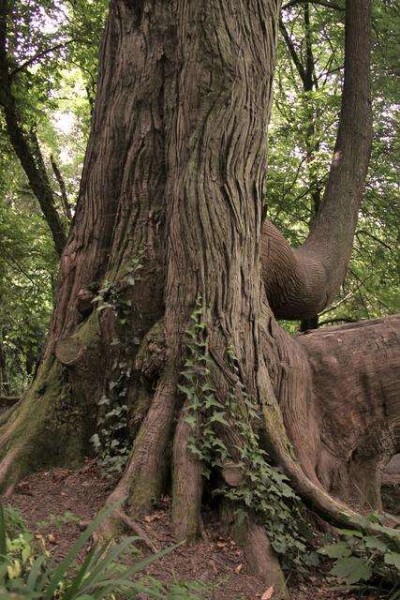|
THYINE WOOD >> Knowledge of the Good Affections received from God
 Before touching upon the proper pines, there is another member of the Cypress group which should be noticed, as it receives a passing mention in the “Apocalypse” under the name of Thyine Wood. Before touching upon the proper pines, there is another member of the Cypress group which should be noticed, as it receives a passing mention in the “Apocalypse” under the name of Thyine Wood.
There seems to be no difference of opinion among commentators in designating as the tree intended one of the Thuyas, of which we possess familiar examples in our Arbor VitŠ, one species of which is native to New England, and others are imported and cultivated in gardens. The native tree (Thuja Occidentalis) is known as the White Cedar in Maine, and is valuable for its soft, fragrant wood, of light reddish-brown color, which is much used for shingles, and also for posts, being very durable.
The foliage of the cultivated trees is made close and thick by pruning, in which state they are planted for hedges, and pruned into quite solid walls and many fanciful shapes. The branches, with their many twigs clad in minute scale-like leaves, are flat; but the flat sprays do not lie horizontally like those of the cedar and the hemlock spruce; there is much variety in their direction, but, on the whole, they have a vertical tendency.
The “Thyine” wood Mr. Grindon describes as follows:
Being highly balsamic and odoriferous, it was used for incense in primeval religious ceremonies, and thence received its name of thu-on, or “wood-of-sacrifice,” as instanced by Homer in his charming description of the enchanted island of Calypso (Od. V. 60). The tree which yields it is the Thuja articulata of Desfontaines, the Callitris quadrivalvis of Ventenat, and the “Algerian Cypress” of English catalogues. Nearly allied to the arbor vitŠ, it presents itself as a branching evergreen, provided with innumerable slender twigs, which are curiously jointed, clothed with minute leaves, and decked, in their season, with a profusion of inconspicuous yellowish flowers.
Upon all the wild and uncultivated hills of Barbary and Mount Atlas it is still to be found, though the majestic examples that grew anciently have seen no successors. The wood was valued not only for its odor when burned, but for its beautiful color—a dark and variegated hazelbrown— and its smooth and solid texture. Under the name of citrus, citron, or citrine wood (just as we nowadays say “rosewood,” the odor of the latter corresponding with that of the flower), it was employed for the highest and most costly descriptions of cabinetwork. Cicero, Martial, and Lucan refer to its splendor and value; while Theophrastus recommends that it should be employed in the building of temples, seeing that edifices dedicated to the deities should be constructed of imperishable materials, and that the callitris wood in particular is one that bids defiance to the hunger of insects.
The sacrifices of the ancients consisted chiefly of innocent animals, and represented the reception of good affections from God, and the acknowledgment of all goodness as His. The custom of offering fragrant resin and gum, and sweet wood, for sacrifice, had its origin in the days when the significance of all these things was understood; and they were employed with careful discrimination and exact intention. The wood, therefore, which preeminently was called the “wood-of-sacrifice,” must preeminently represent the knowledge of the reception of good affections from God.
The distinct horizontal planes of the Cedar represent, as we have seen, a rational discrimination between the several planes of the human mind; but the vertical planes of the Thuya foliage, blended, as they are, without vertical stratification, represent a perception of the principle which unites all planes of the mind from inmost to outmost; and that principle is the love of God. From this point of view, therefore, we come to the same conclusion, that the tree represents a knowledge of the good affections received from God, and of their unity.
Thyine wood is associated in the Bible with “vessels of ivory,” and therefore is said by Swedenborg to represent the natural good correlative to the truth represented by ivory (Apocalypse Revealed #774). Now ivory represents the same as the teeth, which are the guards of the nutrition of the body; and that is, the principles of good life by which everything ought to be examined before it is admitted to the halls of the mind or of the community. The good correlative with such truth is the knowledge of the increase of life from the reception of such things as bear the test. It is the knowledge of the reception of life from God by those who pass the gates of heaven, and the consequent increase of the life of heaven; it is the knowledge of the increase of good affection in the Church by the presence of those who bring upright lives to her service; it is the knowledge of the gift of good affections from God to those who are in the effort to do right.
Author: JOHN WORCESTER 1875
|
|